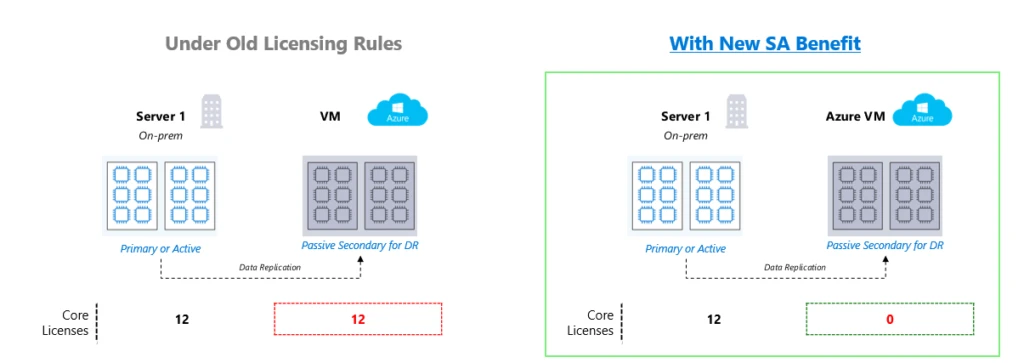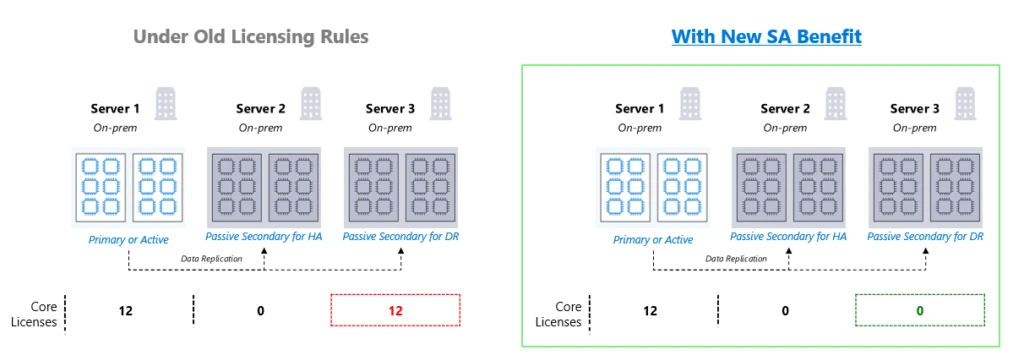New high availability and disaster recovery benefits for SQL Server
Business continuity is a key requirement for planning, designing, and implementing any business-critical system. When you bring data into the mix, business continuity becomes mandatory. It’s an insurance policy that one hopes they never have to make a claim against in the foreseeable future.
SQL Server brings intelligent performance, availability, and security to Windows, Linux, and containers and can tackle any data workload from BI to AI from online transaction processing (OLTP) to data warehousing. You get mission-critical high availability and disaster recovery features that allow you to implement various topologies to meet your business SLAs. A customer with SQL Server licenses with Software Assurance has historically benefited from a free passive instance of SQL Server for their high availability configurations. That helps to lower the total cost of ownership (TCO) of an application using SQL Server.
Today, we are enhancing the existing Software Assurance benefits for SQL Server which further helps customers implement a holistic business continuity plan with SQL Server.
Starting Nov 1st, every Software Assurance customer of SQL Server will be able to use three enhanced benefits for any SQL Server release that is still supported by Microsoft:
- Failover servers for high availability – Allows customers to install and run passive SQL Server instances in a separate operating system environment (OSE) or server for high availability on-premises in anticipation of a failover event. Today, Software Assurance customers have one free passive instance for either high availability or DR
- Failover servers for disaster recovery NEW – Allows customers to install and run passive SQL Server instances in a separate OSE or server on-premises for disaster recovery in anticipation of a failover event
- Failover servers for disaster recovery in Azure NEW – Allows customers to install and run passive SQL Server instances in a separate OSE or server for disaster recovery in Azure in anticipation of a failover event

With these new benefits, Software Assurance customers will be able to implement hybrid disaster recovery plans with SQL Server using our features like Always On Availability Groups without incurring additional licensing costs for the passive replicas.
In the image below, the setup uses SQL Server running on an Azure Virtual Machine utilizing 12 cores as a disaster recovery replica for an on-premises SQL Server deployment using 12 cores. In the past, you would need to license 12 cores of SQL Server for the on-premises and the Azure Virtual Machine deployment. The new benefit offers passive replica benefits running on an Azure Virtual Machine. Now a customer would need to only license 12 cores of SQL Server running on-premises as long as the disaster recovery criteria for the passive replica on Azure Virtual Machine is met.

In the image below, the primary or the active replica uses 12 cores hosting two virtual machines. The topology has two secondary replicas: one sync replica for high availability supporting automatic failovers and one asynchronous replica for disaster recovery without automatic failover. With the announcement of the new benefits, the number of SQL Server core licenses required to operate this topology would be only 12 cores as opposed to 24 cores in the past.

SQL Server 2019 provides a number of improvements for availability, performance, and security along with new capabilities like the integration of HDFS and Apache Spark™ with the SQL Server database engine. Try SQL Server 2019 today and create a robust business continuity plan using our industry leading Software Assurance benefits.
The above high availability and disaster recovery benefits will be applicable to all releases of SQL Server.
In addition to the high availability and disaster recovery benefits, the following operations are allowed on the passive replicas:
- Database consistency checks
- Log backups
- Full backups
- Monitoring resource usage data
The updated benefits will be available in the next refresh of the Microsoft Licensing Terms.
Learn more
Introducing SQL Server 2019
What’s new in SQL Server 2019
SQL Server 2019 editions and features
Microsoft Licensing Terms


